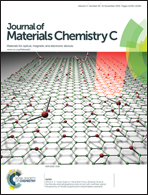Highly efficient yellow phosphorescent organic light-emitting diodes with novel phosphine oxide-based bipolar host materials
Abstract
Two bipolar host materials, (4-((4-(naphthalen-1-yl(phenyl)amino)naphthalen-1-yl)(phenyl)amino)phenyl)diphenylphosphine oxide (POpN) and (3-((4-(naphthalen-1-yl(phenyl)amino)naphthalen-1-yl)(phenyl)amino)phenyl)diphenylphosphine oxide (POmN), comprising a hole-transporting N1-(naphthalen-1-yl)-N1,N4-diphenylnaphthalene-1,4-diamine (NPNA2) donor and an electron-transporting phosphine oxide (PO) acceptor at different positions of the phenyl bridge have been synthesized. POpN (glass transition temperature Tg = 119 °C) and POmN (Tg = 115 °C) exhibit high morphological stability. Two yellow phosphorescent organic light-emitting diodes (PhOLEDs, ITO (indium tin oxide)/TAPC (1,1-bis[4-(di-p-tolylamino)phenyl]cyclohexane, 40 nm)/POpN or POmN: Ir(bt)2(acac) (bis(2-phenylbenzothiozolato-N,C2′)iridium(acetylacetonate), 15 wt%, 20 nm)/TmPyPB (1,3,5-tri(m-pyrid-3-yl-phenyl)benzene, 40 nm)/LiF (1 nm)/Al (100 nm)) exhibit maximum luminances (Lmax) of 82 057 and 78 385 cd m−2, maximum current efficiencies (ηc,max) of 68.28 and 44.95 cd A−1, respectively, with low efficiency roll-off.


 Please wait while we load your content...
Please wait while we load your content...